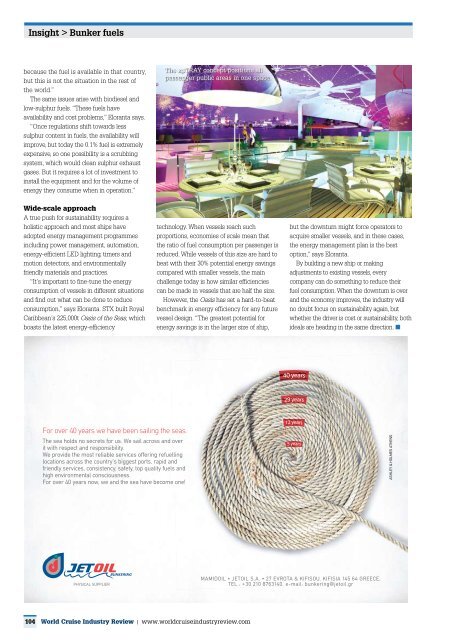Metamorphosis - Cruise Ship Portal
Metamorphosis - Cruise Ship Portal
Metamorphosis - Cruise Ship Portal
You also want an ePaper? Increase the reach of your titles
YUMPU automatically turns print PDFs into web optimized ePapers that Google loves.
Insight > Bunker fuels<br />
because the fuel is available in that country,<br />
but this is not the situation in the rest of<br />
the world.”<br />
The same issues arise with biodiesel and<br />
low-sulphur fuels. “These fuels have<br />
availability and cost problems,” Eloranta says.<br />
“Once regulations shift towards less<br />
sulphur content in fuels, the availability will<br />
improve, but today the 0.1% fuel is extremely<br />
expensive, so one possibility is a scrubbing<br />
system, which would clean sulphur exhaust<br />
gases. But it requires a lot of investment to<br />
install the equipment and for the volume of<br />
energy they consume when in operation.”<br />
Wide-scale approach<br />
A true push for sustainability requires a<br />
holistic approach and most ships have<br />
adopted energy management programmes<br />
including power management, automation,<br />
energy-efficient LED lighting, timers and<br />
motion detectors, and environmentally<br />
friendly materials and practices.<br />
“It’s important to fine-tune the energy<br />
consumption of vessels in different situations<br />
and find out what can be done to reduce<br />
consumption,” says Eloranta. STX built Royal<br />
Caribbean’s 225,000t Oasis of the Seas, which<br />
boasts the latest energy-efficiency<br />
104<br />
The xpTRAY concept positions all<br />
passenger public areas in one space.<br />
technology. When vessels reach such<br />
proportions, economies of scale mean that<br />
the ratio of fuel consumption per passenger is<br />
reduced. While vessels of this size are hard to<br />
beat with their 30% potential energy savings<br />
compared with smaller vessels, the main<br />
challenge today is how similar efficiencies<br />
can be made in vessels that are half the size.<br />
However, the Oasis has set a hard-to-beat<br />
benchmark in energy efficiency for any future<br />
vessel design. “The greatest potential for<br />
energy savings is in the larger size of ship,<br />
World <strong>Cruise</strong> Industry Review | www.worldcruiseindustryreview.com<br />
but the downturn might force operators to<br />
acquire smaller vessels, and in these cases,<br />
the energy management plan is the best<br />
option,” says Eloranta.<br />
By building a new ship or making<br />
adjustments to existing vessels, every<br />
company can do something to reduce their<br />
fuel consumption. When the downturn is over<br />
and the economy improves, the industry will<br />
no doubt focus on sustainability again, but<br />
whether the driver is cost or sustainability, both<br />
ideals are heading in the same direction. �


